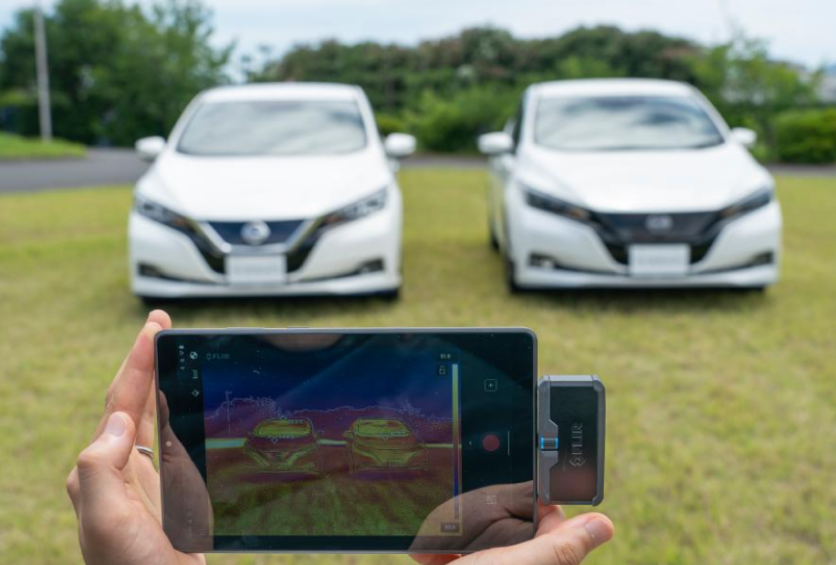Did you know that Nissan's "cool paint" can make the inside of your car cooler? You badly need this one to combat the sweltering temperatures during summer days.
Nissan is pioneering an innovative automotive paint designed to lower vehicle cabin temperatures in summer, reducing the energy demand on air-conditioning systems. This breakthrough paint, developed in collaboration with Radi-Cool, a leader in radiative cooling products, integrates metamaterial technology, offering properties not typically found in nature.
The Technology Behind Nissan's Cool Paint

Nissan's cool paint features metamaterial technology, incorporating two types of microstructure particles. The first particle reflects near-infrared rays, preventing them from heating the vehicle's surface.
The second particle emits electromagnetic waves that counteract the sun's rays, redirecting energy away from the vehicle. Together, these particles significantly reduce heat transfer to the car's exterior surfaces like the roof, hood, doors, and panels.
Related Article : Nissan Stops Investing in New Gas and Diesel Engines as It Remains Steadfast in Its Commitment to All-Electric Future
Real-World Testing at Haneda Airport
In November 2023, Nissan began a 12-month trial at Tokyo International Air Terminal at Haneda. Partnering with Japan Airport Terminal Co., Ltd., Radi-Cool Japan, and All Nippon Airways (ANA) airport services, Nissan applied the cool paint to an NV100 service vehicle operated by ANA. The expansive, open tarmac at Haneda provided an ideal testing environment to evaluate the paint's performance in high-temperature conditions.
Impressive Results from Initial Tests
Even in its testing phase, Nissan's cool paint has shown remarkable results. Vehicles coated with this paint demonstrated a reduction of up to 21.6 degrees Fahrenheit in exterior surface temperatures and up to 9 degrees Fahrenheit cooler interiors compared to those with traditional automotive paint.
Furthermore, this cooling effect is particularly beneficial when vehicles are parked in the sun for extended periods, reducing the need for prolonged air-conditioning use, which in turn lowers the load on the engine or battery, improving overall efficiency.
Dr. Susumu Miura, a senior manager and expert at Nissan's Advanced Materials and Processing Laboratory, leads this project. Dr. Miura has a history of developing award-winning materials at Nissan, including noise-reducing acoustic materials. His current focus is on creating efficient, cooling automotive paints that can be applied with a spray gun and meet Nissan's stringent quality standards.
"My dream is to create cooler cars without consuming energy" explained Miura. "This is especially important in the EV era, where the load from running air-conditioning in summer can have a sizable impact on the state of charge," Miura said in Nissan's latest blog.
Overcoming Development Challenges
Creating an automotive version of radiant cooling paint posed several challenges. Traditional radiant cooling paints, used on buildings, are thick, applied with rollers, and lack clear topcoats, often leaving a chalky residue.
According to ABC News, the paint's coating is six times thicker, posing some hurdles when it comes to commercialization.
Dr. Miura's team needed to develop a version that could be sprayed, included a clear topcoat, and met all of Nissan's durability standards.
After testing over 100 samples, the team confirmed a paint thickness of 120 microns, offering resistance to salt, chipping, peeling, scratches, and chemical reactions, along with maintaining color consistency and repairability.
Future Applications and Potential
As development continues, Dr. Miura and his team aim to refine the paint's thickness while maintaining its cooling performance. Their goal is to offer this paint for special orders in various colors. This technology shows significant potential for light commercial vehicles, such as vans, trucks, and ambulances, which spend most of their operational time outdoors.
Indeed, this paint has the potential to become a standard feature, particularly for vehicles exposed to prolonged sunlight, reducing energy consumption and contributing to a more sustainable future. However, commercialization is still another problem that the team needs to solve.





